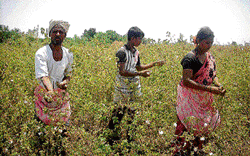
The production of Jayadhar cotton, which was once an important ‘desi’ strain, has dropped drastically. There is a need to revive this crucial native strain,writes R S Patil .
There was a time when you could see Jayadhar cotton in every field in North Karnataka. The black soil of the region suited the cultivation of this strain of cotton.At least 60 per cent of the land that every farmer owned was set aside for growing Jayadhar cotton.
This native strain of cotton was grown successfully both as a single crop and as an inter-crop, alongside potato, garlic and chilli. Farmers would typically take up sowing by September or October.
There are many reasons why farmers took to this strain of cotton. Not much expenditure was needed for sowing or weed management. Because it was a native strain, it had excellent disease and pest-resistant qualities. Also, this strain thrives in the most severe summers.
Unlike hybrid cotton, this strain does not require too much water or pesticide. Even in dry soil conditions, this variety yields three-four quintals of cotton. With some water supply, there have been instances of this strain yielding seven-eight quintals per acre.
Though there are over 45 species of cotton the world over, in India, there are only four varieties that are four commercially grown ones, according to Siruguppa’s cotton expert Jayaprakash Nidagundi.
One of them is gossypium herbaceum. Apart from Jayadhar, there are other species under this category, including Suyodhar and Renuka. Gossypium herbaceum is a native variety. The other variety, called gossypium arboreum, is grown in the Raichur region. Pandrapura and AK-245 belong to this category.
Though gossypium barbadense and hirsutum are American strains, they have adapted themselves well to Indian conditions, and are today as good as Indian strains. Then, there are BT strains of cotton, which are produced by using bacillus thuringiensis, a bacterium that is present in the soil.
Yield of desi strains of cotton, principal among them, Jayadhar, has dropped drastically, from 97 per cent to three per cent, according to Dharwad Agriculture University’s Hebballi Cotton Research Centre’s senior scientist S S Patil.
The reasons for the drop in yield of desi strains is the high interest among farmers to opt for more resistant strains. Also, they claim that the yield from desi strains is lower than the others. No matter what, it is crucial that this strain does not disappear, because without the genes of desi strains, it is impossible to develop resistant strains.
Today, Jayadhar cotton is mostly used in the manufacture of denim, surgical cotton, bedsheets etc.
At one point, this strain of cotton was being exported to many countries, but today, it is imported from Israel and Egypt, say experts Jayaprakash and Chandrakanth Kalibaavi. They stress the importance of reviving desi strains of cotton.